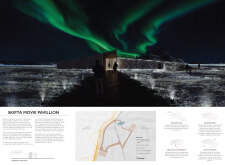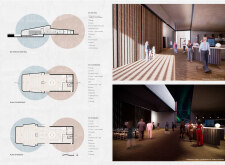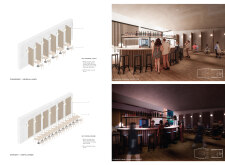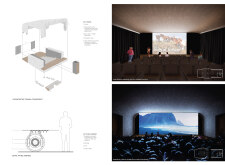5 key facts about this project
Functionally, the Skipta Movie Pavilion is designed to accommodate various public events, including movie screenings, community gatherings, and social activities. The flexible layout allows for different seating arrangements, promoting an inclusive environment where both large groups and smaller, more intimate gatherings can be hosted. The architectural plans reveal distinct functional zones tailored for diverse user needs, ensuring versatility while maintaining an inviting atmosphere for all visitors.
From a design perspective, the pavilion showcases a curvilinear form that resonates with the natural elements surrounding it. These flowing shapes create a dialogue between the built environment and the rugged Icelandic landscape. The thoughtful arrangement of space allows the pavilion to blend into its surroundings, minimizing its visual impact while enhancing the overall aesthetic of the site. The interplay of interior and exterior spaces is achieved through ample glass surfaces that provide unobstructed views of the breathtaking vistas, allowing natural light to flood the common areas while establishing a strong connection with the environment.
Material selection is one of the most critical aspects of the pavilion's design. The use of local materials, including reinforced concrete, softwoods, and acoustic panels, not only promotes sustainability but also supports the local economy. Reinforced concrete serves as a primary structural element, ensuring durability against the elements, while wood adds warmth to the interiors and complements the naturalistic theme. The acoustic panels serve a dual purpose: enhancing sound quality for the cinema experience and providing a visually appealing texture to the walls.
Unique design approaches are evident throughout the architecture of the Skipta Movie Pavilion. The integration of flexible space usage within the layout, along with an emphasis on environmental integration, sets the project apart. The design takes into account local climate conditions, utilizing natural airflows and thermal properties to create an energy-efficient building that is responsive to its environment. This commitment to sustainability is paramount in promoting responsible architectural practices and aligning with the broader goal of preserving the natural characteristics of the region.
Moreover, the pavilion champions community engagement by serving as a cultural hub for the local populace. By frequently hosting various community events and activities, it aims to foster a deeper sense of connection among residents and visitors. The design encourages participation, where social interactions are seamlessly woven into the very fabric of the architectural experience.
To gain a deeper understanding of the Skipta Movie Pavilion and its architectural ideas, readers are encouraged to explore the project's presentation, including details such as architectural plans and sections. This examination will provide valuable insights into the comprehensive design process and the thoughtful considerations that shaped this unique project.


























